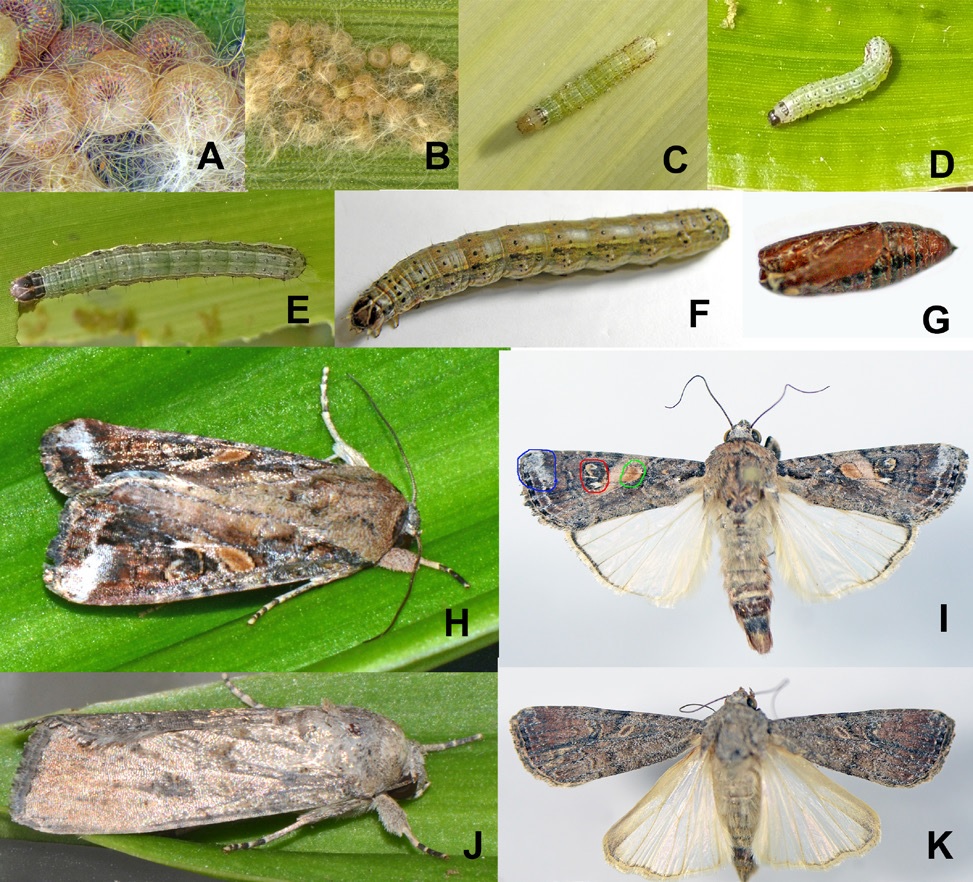|
Spodoptera frugiperda (J. E. Smith)
Taxonomic position
Insecta: Lepidoptera: Noctuidae
Common names
Fall armyworm (FAW)
Habitat / Crop(s) damaged
Maize primarily but known to feed on more than 100 plant species (several grain crops, vegetables, and wild plants). Infestation recently observed on Sorghum in southern Karnataka.
Brief Diagnosis
FAW has a short development cycle with high reproduction rate of about 1000 eggs per female. FAW is a highly prolific migrant and a potentially dangerous pest as it has remarkable long-distance flight ability.
Pest status
Distribution and spread
FAW is native to the tropical and subtropical regions of the Americas, also occurs in the southern states of the USA. In January 2016, it was first reported in South-Western Nigeria, later it spread to the Central and Western Africa and subsequently to Southern Africa. In 2017, it was reported from Ghana. In Nigeria and São TomeÂ, the presence of at least two distinct haplotypes within samples collected on maize suggests multiple introductions into the African continent (Goergen et al. 2016).
In India, it was first noticed in mid-May 2018 in Shivamogga, Karnataka following which massive surveys were undertaken and now it has been reported from multiple locations viz. Chikkaballapur, Hassan, Chikkamagaluru, Belgaum, Davanagere, Chitradurga, Doddaballapur, Chintamani, Gowribidnur and Madhugiri (team NBAIR, UAHS Shivammoga and UAS-Bangalore). The pest attack was also discovered by a team of scientists attached to the Krishi Vigyan Kendra of Karur when they carried out field surveys on maize crop at Nathamedu of Krishnarayapuram block and Karuppur of Thanthoni block in Karur district on 09/08/2018. Also noticed in Ranasthalam village, Srikakulam district; Pusapatirega, Vizianagaram district; at RARS farm, Anakapalle of North Coastal zone and at RARS farm, Chinthapalli in high altitude zone of Andhra Pradesh on 10/08/2018 by ANGRAU Scientists. So far FAW is reported from Karnataka, Telengana, Andhra Pradesh, Maharastra and Tamil Nadu. Massive surveys on war footing are undergoing.
Nature of damage
Fig. 1. Damage symptoms of S. frugiperda in the maize field: A, young larva leaving silvery transparent membrane; B, larva feeding inside whorl with faecal matter; C&D, tassel feeding by larvae; E & F, feeding symptoms.
Life stages

Fig. 2. Life stages of S. frugiperda: A & B, eggs; C-F, larval instars; H, adult male in habitus; I, adult male (dorsal view); J, adult female in habitus; K, adult female (dorsal view).
Photo Credit: Ankita Gupta
Egg (Figs 2A, B): Egg laying occurs on the inner side of the whorl and also on the under surface of the leaf in a mass deposited in layers (observations from field- 89 eggs arranged in layers/patch as shown in Fig. 2B). The eggs are dome shaped brownish yellow coloured and loosely covered with pale yellowish coloured frass. On higher magnification, shining reticulated surface can be easily noticed. The egg diameter and height ranges as 0.49-0.51 and 0.35-0.37, respectively.
Larval stages (Figs 2C-F): First instar larva is greenish in colour with black head while the final instars are with dark grey head and dull grey body with white subdorsal and lateral white lines. The mature larva is with a white inverted "Y" mark on the head and with distinct black spots on the body. Arrangement pattern of black spots is square on 8th and trapezoidal on 9th segment (Fig 2E).
Pupa Pupa is reddish brown in color and pupation occurs in the soil.
Adult (Figs 2H-K): Sexual dimorphism is clearly evident in the adult moths. Adult male forewing (Figs 2H & I) is greyish brown with reniform indistinct spot, faintly outlined in black, with a small v-shaped mark (Fig. 2I, marked with red coloured circle); light brown orbicular spot, somewhat oval and oblique in shape (Fig. 2I, marked with green coloured circle) and white patch at the apical margin of the wing (Fig. 2I, marked with blue coloured circle). Adult female forewing (Figs 2J & K) is with a mottled colouration of grey and brown, with brown markings and without white patch near apical margin of the wing as seen in male.

Fig. 2I. (Enlarged view of adult male of Spodoptera frugiperda)
Parasitoid complex
Fig. 3. Parasitoid complex of S. frugiperda: A-C, parasitized eggs of S. frugiperda with Telenomus sp.; D-F, parasitized eggs of S. frugiperda with Trichogramma sp.; G, cocoons of larval parasitoid Glyptapanteles creatonoti; adult female wasp of G. creatonoti; I, larval parasitoid Campoletis chlorideae Uchida; J, indet. ichneumonid larval-pupal parasitoid.
Photo Credit: Ankita Gupta
References
Ganiger PC, Yeshwanth HM, Muralimohan K, Vinay N, Kumar ARV, Chandrashekara K. Occurrence of the new invasive pest, fall armyworm, Spodoptera frugiperda (J.E. Smith) (Lepidoptera: Noctuidae), in the maize fields of Karnataka, India. Current Science, VOL. 115, NO. 4, 25 August 2018.
Goergen G, Kumar PL, Sankung SB, Togola A, TamòM. 2016. First Report of Outbreaks of the Fall Armyworm Spodoptera frugiperda (J. E. Smith) (Lepidoptera, Noctuidae), a new alien invasive pest in West and Central Africa. PLoS ONE 11(10): e0165632. doi:10.1371/journal.pone.0165632.
IITA. 2018. Fall armyworm has reached the Indian subcontinent! http://www.iita.org/news-item/fall-armyworm-has-reached-the-indian-subcontinent/ (published 04/08/2018).
ICAR-NBAIR. 2018. Pest Alert: Spodoptera frugiperda (J. E. Smith) (Insecta: Lepidoptera) (published 30/07/2018).
Sharanabasappa, Kalleshwara swamy CM. 2018. Presence of Fall Armyworm, Spodoptera frugiperda (J. E. Smith) (Lepidoptera: Noctuidae), an Invasive Pest on Maize in University jurisdiction. University of Agricultural and Horticultural Sciences, Shivamogga, Karnataka, India. https://drive.google.com/file/d/1hEW58nhZViHPnRduCjRHVIfWhGASHLSH/ (published 20/07/2018).
Shylesha AN, Jalali SK, Gupta A, Varshney R, Venkatesan T, Shetty P, Ojha R, Ganiger PC, Navik O, Subaharan K, Bakthavatsalam N and Ballal CR, 2018. Studies on new invasive pest Spodoptera frugiperda (J. E. Smith) (Lepidoptera: Noctuidae) and its natural enemies. Journal of Biological Control, 32(3): 1-7, 2018, DOI: 10.18311/jbc/2018/21707.
Credits
Factsheet prepared under Dr Chandish R. Ballal's directorship by Dr Ankita Gupta with inputs from Drs A. N. Shylesha, S. K. Jalali, Richa Varshney, Prabhu C. Ganiger (UAS-B) and Omprakash Navik, NBAIR. Web content added by Lavanya, 08/08/2018 (updated on 06/09/2018).
|